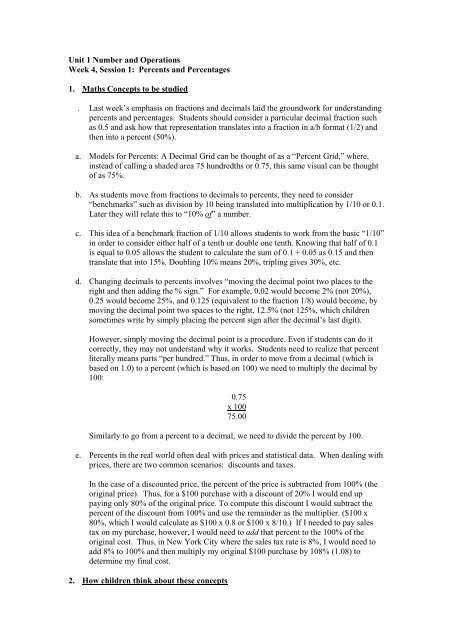Course Guide - USAID Teacher Education Project
Course Guide - USAID Teacher Education Project
Course Guide - USAID Teacher Education Project
Create successful ePaper yourself
Turn your PDF publications into a flip-book with our unique Google optimized e-Paper software.
Unit 1 Number and OperationsWeek 4, Session 1: Percents and Percentages1. Maths Concepts to be studied. Last week’s emphasis on fractions and decimals laid the groundwork for understandingpercents and percentages. Students should consider a particular decimal fraction suchas 0.5 and ask how that representation translates into a fraction in a/b format (1/2) andthen into a percent (50%).a. Models for Percents: A Decimal Grid can be thought of as a “Percent Grid,” where,instead of calling a shaded area 75 hundredths or 0.75, this same visual can be thoughtof as 75%.b. As students move from fractions to decimals to percents, they need to consider“benchmarks” such as division by 10 being translated into multiplication by 1/10 or 0.1.Later they will relate this to “10% of” a number.c. This idea of a benchmark fraction of 1/10 allows students to work from the basic “1/10”in order to consider either half of a tenth or double one tenth. Knowing that half of 0.1is equal to 0.05 allows the student to calculate the sum of 0.1 + 0.05 as 0.15 and thentranslate that into 15%. Doubling 10% means 20%, tripling gives 30%, etc.d. Changing decimals to percents involves “moving the decimal point two places to theright and then adding the % sign.” For example, 0.02 would become 2% (not 20%),0.25 would become 25%, and 0.125 (equivalent to the fraction 1/8) would become, bymoving the decimal point two spaces to the right, 12.5% (not 125%, which childrensometimes write by simply placing the percent sign after the decimal’s last digit).However, simply moving the decimal point is a procedure. Even if students can do itcorrectly, they may not understand why it works. Students need to realize that percentliterally means parts “per hundred.” Thus, in order to move from a decimal (which isbased on 1.0) to a percent (which is based on 100) we need to multiply the decimal by100:0.75x 10075.00Similarly to go from a percent to a decimal, we need to divide the percent by 100.e. Percents in the real world often deal with prices and statistical data. When dealing withprices, there are two common scenarios: discounts and taxes.In the case of a discounted price, the percent of the price is subtracted from 100% (theoriginal price). Thus, for a $100 purchase with a discount of 20% I would end uppaying only 80% of the original price. To compute this discount I would subtract thepercent of the discount from 100% and use the remainder as the multiplier. ($100 x80%, which I would calculate as $100 x 0.8 or $100 x 8/10.) If I needed to pay salestax on my purchase, however, I would need to add that percent to the 100% of theoriginal cost. Thus, in New York City where the sales tax rate is 8%, I would need toadd 8% to 100% and then multiply my original $100 purchase by 108% (1.08) todetermine my final cost.2. How children think about these concepts
















